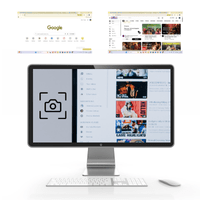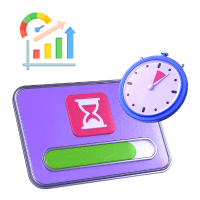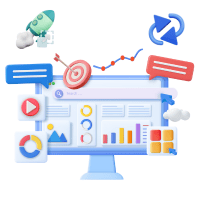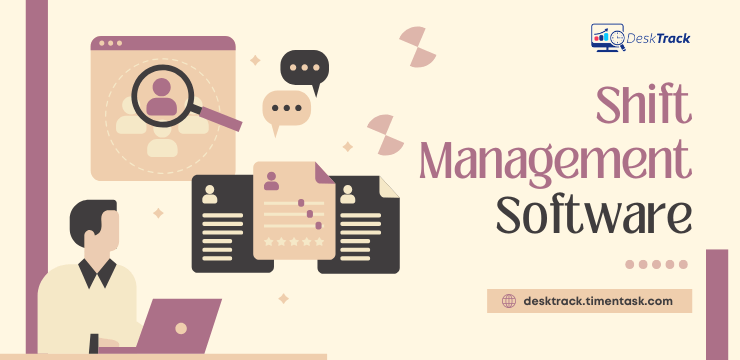
In the modern workplace, managing employee shifts efficiently is a critical challenge for businesses of all sizes. With increasingly complex schedules, remote teams, and evolving labor laws, traditional manual scheduling methods are no longer effective or sustainable. This is where shift management software plays a transformative role.
Shift management software automates and streamlines employee scheduling, offering real-time updates, communication tools, and compliance tracking. In 2025, businesses that leverage these tools gain a competitive edge by enhancing operational efficiency, reducing labor costs, and improving employee satisfaction. Whether you run a retail store, hospital, or manufacturing plant, adopting a powerful shift management solution is a strategic investment.
This comprehensive guide dives deep into why shift management software is essential for your business in 2025, explores its key features and benefits, and provides actionable tips for selecting the right tool, culminating in a spotlight on DeskTrack, a market-leading platform that stands out in this space.
What Is Shift Management Software?
Shift management software is an advanced digital solution designed to simplify the creation, adjustment, and oversight of employee work schedules. It moves away from manual methods – like spreadsheets or paper rosters, and instead provides automated, centralized scheduling capabilities that improve accuracy and communication.
In today’s fast-paced business world, managing shift schedules manually often leads to inefficiencies, errors, and unhappy employees. Shift management software digitizes this process, offering managers and employees a transparent, easy-to-use platform for organizing shifts, requesting changes, and tracking attendance. This section explains what shift management software is and the fundamental functionalities that make it indispensable.
Automates Scheduling Tasks
Shift management software removes the burden of manually assigning shifts by automating repetitive tasks such as matching employee availability with required shift times. It can detect conflicts like double bookings or overlapping shifts and resolve them proactively, saving time and reducing errors.
Centralized Employee Data
All relevant employee information—such as availability, time-off requests, skills, and shift history is stored in one accessible location. This central repository ensures that managers have up-to-date data for smarter scheduling decisions, and employees can easily check their upcoming shifts and preferences.
Provides Real-Time Updates
With built-in notification systems, shift management tools instantly inform employees about schedule changes, shift swaps, or new assignments via mobile alerts, emails, or app notifications. This real-time communication minimizes missed shifts and improves accountability.
Enhances Visibility for Managers
Managers get access to visual calendars, dashboards, and reports that provide a bird’s-eye view of workforce coverage, shift fulfillment, and attendance patterns. This transparency helps in optimizing labor resources and spotting potential staffing gaps.
Supports Business Growth
As businesses grow and schedules become more complex, shift management software scales effortlessly. It adapts to changing workforce sizes, multiple locations, and industry-specific requirements, helping companies maintain efficient operations regardless of their complexity.
Read Also: Top 10 PTO Tracking Software for Businesses in 2025
Challenges of Manual Shift Scheduling
Before exploring the benefits of shift management software, it’s important to understand the common pitfalls of relying on manual scheduling techniques. Many businesses continue using spreadsheets, whiteboards, or paper schedules, which introduce significant challenges.
Manual shift scheduling is not only time-intensive but also prone to mistakes that impact productivity and employee morale. This section explores the key challenges businesses face when they rely on traditional scheduling methods and why moving to a software solution is critical for operational success.
1. Time-Consuming Processes
Creating, updating, and communicating schedules manually requires extensive time from HR or management, distracting them from strategic priorities. This process often takes hours each week, especially for larger teams or businesses with complex shift patterns.
2. Increased Errors and Conflicts
Manual scheduling increases the risk of errors like overlapping shifts, missed breaks, or violating labor laws around overtime. These mistakes can lead to employee dissatisfaction, legal penalties, or operational disruptions.
3. Poor Communication
Without a centralized platform, shift changes are often communicated via phone calls, texts, or emails, leading to missed messages and confusion. Employees may arrive for the wrong shifts or fail to get timely updates.
4. Low Employee Satisfaction
Rigid and opaque scheduling systems frustrate employees, limiting their ability to swap shifts or request time off easily. This lack of flexibility and transparency leads to burnout, absenteeism, and high turnover rates.
5. Impact on Business Operations
Inefficient scheduling can cause understaffing during peak times or overstaffing during slow periods, both of which affect service quality and profitability. This misalignment reduces customer satisfaction and strains internal resources.
Key Benefits of Using Shift Management Software

Shift management software addresses the challenges of manual scheduling while adding powerful capabilities to enhance workforce management and business outcomes.
By automating and centralizing scheduling, shift management software delivers tangible benefits in operational efficiency, communication, employee engagement, and regulatory compliance. This section details the most important advantages companies gain by adopting these tools.
1. Streamlined Scheduling and Automation
Automated scheduling features dramatically reduce the time managers spend building rosters, freeing them up to focus on other critical tasks. Tools often include templates for recurring shifts, automatic conflict detection, and rules-based scheduling.
2. Real-Time Updates and Notifications
Instant alerts keep employees and managers informed about shift assignments, cancellations, or swap requests. This responsiveness reduces absenteeism and improves accountability across teams.
3. Improved Staff Communication
Integrated communication tools provide a centralized hub for sharing announcements, shift instructions, and feedback, promoting transparency and collaboration among staff.
4. Higher Employee Satisfaction
Allowing employees to view schedules, request shifts, and submit time-off requests via self-service portals fosters a sense of control and flexibility. Happier employees are more engaged and less likely to leave.
5. Better Compliance and Labor Law Tracking
Automated tracking of work hours, breaks, and overtime ensures adherence to labor laws and collective agreements. This helps avoid costly fines and keeps the business audit-ready.
Essential Features to Look For in Shift Management Software
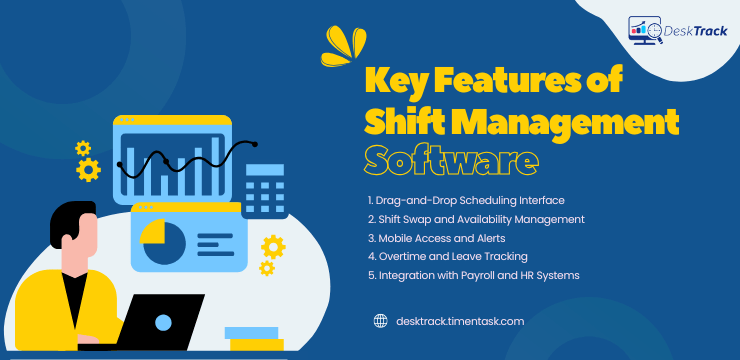
Not all shift management software is created equal. Knowing which features matter most will help you choose a tool that fits your specific needs.
When evaluating shift management software, it’s essential to consider features that streamline scheduling, enhance communication, and integrate with your existing workflows. This section highlights the critical capabilities to prioritize during your selection process.
1. Drag-and-Drop Scheduling Interface
A user-friendly, visual scheduling board lets managers quickly assign and rearrange shifts without complex coding or data entry. This ease of use accelerates adoption and reduces training needs.
2. Shift Swap and Availability Management
Enabling employees to propose shift swaps or indicate availability through the software fosters flexibility while maintaining managerial oversight and preventing scheduling conflicts.
3. Mobile Access and Alerts
Modern workforces expect to manage schedules from their smartphones. Apps for iOS and Android that provide real-time alerts empower staff to stay updated no matter where they are.
4. Overtime and Leave Tracking
Accurate tracking of hours worked and leave taken prevents overpayments, reduces fatigue risks, and helps managers control labor costs effectively.
5. Integration with Payroll and HR Systems
Seamless syncing with payroll, attendance, and HR software eliminates duplicate data entry, improves accuracy, and streamlines end-to-end workforce management.
Industries That Benefit Most of Shift Management Software
Shift management software is versatile but is especially transformative in certain industries with complex scheduling needs.
Some industries face unique challenges related to shift planning, workforce distribution, and compliance requirements. This section explores how shift management software is applied in these sectors to improve operational outcomes.
1. Healthcare and Hospitals
Healthcare requires 24/7 coverage with complex shift rotations and strict compliance needs. Software helps ensure proper staffing, reduces burnout, and tracks certifications.
2. Retail and E-commerce
Retail environments benefit from scheduling aligned to peak customer traffic, managing part-time staff, and accommodating seasonal demand fluctuations efficiently.
3. Manufacturing and Warehousing
Shift planning in manufacturing must align with production targets and safety regulations. Real-time monitoring of shift fulfillment prevents downtime.
4. Hospitality and Restaurants
Fast-paced hospitality operations rely on flexible scheduling to match reservations and customer flow, while ensuring breaks and labor laws are respected.
5. Remote and Hybrid Workforces
Shift management tools are crucial for coordinating teams working across different time zones or remotely, providing visibility and real-time communication.
How to Choose the Right Shift Management Software
Make your workday more productive
Time tracking and work management can help you reach your goals
faster.
Selecting the ideal software requires aligning features, usability, and cost with your organizational needs and growth plans.
With many options available, it’s important to approach selection strategically. This section outlines key considerations to help you identify a solution that fits your workforce size, complexity, and industry.
1. Assess Your Workforce Size and Complexity
Small teams might prefer simple scheduling, while larger enterprises require automation and deep analytics. Understand your current and future scheduling demands.
2. Compare Core Features and Integrations
Identify the features critical for your operation and check how well the software integrates with your existing payroll, HR, or time tracking systems.
3. Prioritize Usability and Mobile Access
Ensure the platform is easy for both managers and employees to use, with robust mobile apps for on-the-go access.
4. Evaluate Cost and Scalability
Compare pricing models and verify that the tool can grow with your business without unexpected cost hikes.
5. Look for Vendor Support and Training
Good customer support and onboarding resources make deployment smoother and encourage long-term success.
Top 5 Shift Management Software in 2025
Here’s a detailed look at five of the best shift management software solutions currently available, with longer descriptions highlighting their unique strengths.
1. DeskTrack
DeskTrack is an all-in-one workforce management and shift scheduling platform that combines robust scheduling features with time tracking and productivity analytics. Its intuitive drag-and-drop scheduler, mobile apps, and real-time notifications make it ideal for businesses looking to automate shift management while gaining actionable insights into workforce productivity. DeskTrack also excels in compliance management, helping organizations avoid costly labor law violations. Its scalability ensures it supports everything from small teams to large, multi-location enterprises, making it the best choice for 2025 and beyond.
2. When I Work
When I Work is designed for hourly workers and focuses on simplicity and ease of use. It offers flexible shift scheduling, team messaging, and availability management, all accessible via mobile apps. It’s particularly popular with small to medium-sized retail and restaurant businesses that need a straightforward yet powerful scheduling tool.
3. Deputy
Deputy offers AI-driven scheduling capabilities that optimize shifts based on employee availability, labor laws, and business demand. With strong mobile functionality, Deputy also supports time and attendance tracking, task management, and integrates with a wide range of payroll systems. Its powerful reporting tools help managers identify scheduling inefficiencies and labor cost savings, making it a strong contender for growing companies.
4. Shiftboard
Shiftboard targets large enterprises and industries with complex scheduling needs like healthcare, public safety, and manufacturing. It supports high-volume shift assignments, compliance tracking, and detailed workforce analytics. Shiftboard’s ability to handle rotating and on-call shifts makes it a reliable choice for organizations requiring precision and scale.
5. Connecteam
Connecteam is a mobile-first platform tailored for deskless and frontline workers. It combines shift scheduling, communication, and task management in one app, providing easy access to schedules and company updates. This tool is ideal for businesses that want to improve employee engagement and coordination without complicated software.
Implementation Tips for the Success of Shift Management Software

Successfully rolling out shift management software requires strategic planning, communication, and continuous improvement.
Adopting new software can be disruptive without the right approach. This section offers practical tips to help businesses implement shift scheduling tools smoothly, ensuring high adoption and maximum return on investment.
1. Involving Staff in the Rollout
Engage team leads and employees early to gather input and build buy-in. Champions can help train colleagues and foster positive attitudes towards the new system.
2. Creating Clear Scheduling Policies
Establish and document rules around shift assignments, swaps, and time-off requests. Clear policies help manage expectations and reduce conflicts.
3. Training Managers and Employees
Provide comprehensive onboarding with live demos, guides, and ongoing support to ensure all users feel confident using the platform.
4. Monitoring and Adjusting Based on Feedback
Solicit regular feedback during the initial months and make adjustments based on user experience and operational needs.
5. Measuring ROI and Productivity Gains
Track key performance indicators like labor cost savings, absenteeism rates, and scheduling accuracy to quantify the software’s impact.
Read Also: Is Laptop Screen Monitoring Software Legal & Ethical in 2025?
Common Mistakes to Avoid for Shift Management Software
Awareness of common pitfalls can save time and money, ensuring your shift management solution delivers on its promises.
Even the best software can fail to deliver value if implemented poorly or misaligned with business needs. This section outlines mistakes to avoid when adopting and using shift management software.
1. Choosing Overly Complex Software
Avoid products with unnecessary features that complicate workflows. Focus on software that fits your team’s technical comfort level and scheduling complexity.
2. Ignoring Mobile Usability
Neglecting mobile access can hinder employee engagement, especially for hourly or remote workers who rely on smartphones for communication.
3. Lack of Employee Input
Scheduling works best as a collaborative process. Ignoring employee preferences and feedback reduces satisfaction and increases turnover risk.
4. Failing to Integrate with Payroll
Disconnected systems create inefficiencies and increase errors. Integration streamlines data flow and improves accuracy.
5. Not Monitoring Compliance Features
Failing to use built-in compliance tools can expose your business to legal risks and fines. Stay vigilant about labor law adherence.
Conclusion
Efficient shift management is a cornerstone of modern workforce management. As businesses navigate complex scheduling demands in 2025, the right shift management software can transform operations, reduce costs, and improve employee morale. Manual methods are no longer viable in today’s rapidly changing work environment.
Among the myriad of options, DeskTrack stands out as the premier solution, offering a comprehensive, easy-to-use platform that scales with your business needs. Its powerful scheduling automation, mobile accessibility, and compliance features make it the go-to tool for forward-thinking companies.
By investing in DeskTrack, businesses not only streamline shift scheduling but also unlock productivity insights that drive smarter decisions, ensuring workforce efficiency and satisfaction well into the future.
Frequently Asked Questions (FAQ)
Q1. What’s the best software for small teams?
Ans. DeskTrack’s scalable pricing and user-friendly interface make it ideal for small businesses just starting.
Q2: Can shift software handle overnight shifts?
Ans. Yes, Most modern shift management tools, including DeskTrack, support 24/7 scheduling with rotating and overnight shifts.
Q3: Is mobile access necessary?
Ans. Absolutely, Mobile apps provide employees with schedule visibility and notifications anywhere, enhancing flexibility and communication.
Q4: How secure is shift scheduling software?
Ans. Top-tier solutions like DeskTrack employ strong encryption, role-based access controls, and comply with data protection regulations.
Q5: What’s the ROI of using shift management tools?
Ans. Organizations often see ROI within months, through reduced labor costs, fewer scheduling errors, and improved employee retention.




